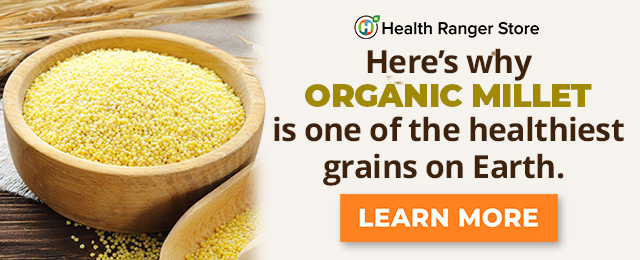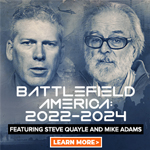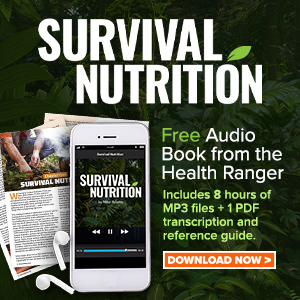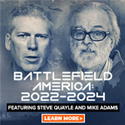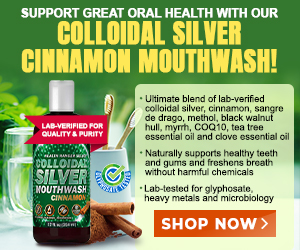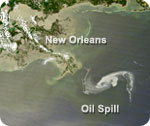
Gulf still loaded with chemicals, but FDA says seafood safe to eat
Thursday, November 04, 2010 by: Ethan A. Huff, staff writer
Tags: Gulf oil spill, FDA, health news
- Newly released JFK files reveal Pentagon's role in creating Lyme disease and covid in the same lab
- Discovery of vast underground city beneath Giza pyramids challenges human history
- Black cumin seed oil emerges as a powerful ally against breast cancer and chronic inflammation
- Sugar-free deception: Artificial sweeteners hijack hunger signals, fuel obesity epidemic, study warns
- Catastrophic 7.7 earthquake devastates Myanmar and Thailand; death toll could reach 100,000
- Kiss Your Genetic Privacy Good-Bye! 23andMe Gets Green Light to Sell Your Intimate Genetic Details to Anyone They Want
- AI breakthrough slashes celiac disease diagnosis time from months to minutes
- Europe braces for WAR as EU urges citizens to STOCKPILE FOOD, in latest provocations with Russia
- Aluminum pollution: A silent threat to human health
- Thomas Massie’s Dual Loyalty Disclosure Act aims to restore American sovereignty by cracking down on foreign influence in Congress
- Putin vows to 'finish off' Ukraine, accuses West of prolonging the war
- Dr. Suzanne Humphries makes bombshell appearance on Joe Rogan podcast, exposing vaccine industry deception back to POLIOMYELITIS
- The cancer fear industry: How big pharma profits from panic-and what natural alternatives offer
- The mighty Eggplant: An underrated superfood with ancient roots
- 200 Tesla showrooms bracing for Saturday protests as movement against Musk escalates
- Is the vaccine-autism debate reopening? Washington Post sparks controversy with preemptive hit piece on David Geier
- The great crypto power struggle: How technocrats and governments are reshaping global finance
- A handful of pecans a day could keep heart disease at bay, study finds
- Newly released JFK files reveal Pentagon's role in creating Lyme disease and covid in the same lab
- Analysis: The coming economic collapse, a mass uprising and Trump's three secret weapons to halt the growing revolt
- Trump nominates VACCINE ZEALOT Susan Monarez to lead the CDC, sidelining RFK Jr.'s reform efforts
- Trump's greatest betrayal so far: Accelerating Middle East wars, silencing dissent, and serving Zionist masters
- Dr. Mike Yeadon releases 15-minute testimony - WATCH - about genocidal intent of COVID “vaccines”
- Festive flavors: The sweet history, nutritional profile and health benefits of pecan pie
- Elon Musk: Aliens could be here on Earth RIGHT NOW
- Big Pharma's $8 Billion bribery scheme exposed: how doctors are pushed to prescribe junk science, not heal
- 5 Simple steps to boost your brainpower: How to strengthen executive function in a distracted world
- Trump reverses course on Gaza plan, says “nobody is expelling Palestinians”
- A lack of integrity in Academia: Harvard professor found GUILTY of fraudulent research to promote CRT theory
- Reclaim your health: How midlife exercise reverses years of inactivity
- Survival 101: Effective EMF blocking techniques
- Florida takes a stand: DeSantis proposes permanent ban on mRNA vaccine mandates
- Sugarcane extract superior to cholesterol-lowering drugs?
- California's social media censorship law struck down: A victory for free speech or a threat to online safety?
- OpenAI whistleblower who dissented against how the company trained ChatGPT found dead
- EPA advisor admits the agency is funneling billions to climate groups ahead of Trump’s return to White House
- EPA advisor admits the agency is funneling billions to climate groups ahead of Trump’s return to White House
- Newly released JFK files reveal Pentagon's role in creating Lyme disease and covid in the same lab
- California's social media censorship law struck down: A victory for free speech or a threat to online safety?
- Dr. Mike Yeadon releases 15-minute testimony - WATCH - about genocidal intent of COVID “vaccines”
- The Health Ranger releases “Vaccine Zombie” song and music video, using AI-animated zombies for the music video
- The pandemic as a tool for INDOCTRINATION: Understanding “The Indoctrinated Brain” by Dr. Michael Nehls
- Florida takes a stand: DeSantis proposes permanent ban on mRNA vaccine mandates
- “Why we influenced the 2020 elections”: Facebook files reveal the coordinated effort to bury the Hunter Biden laptop story
- Mike Adams releases country western hit single: Goin’ Back in Time is Comin’ Home
- Mike Adams releases music poetry sensation: A Child of God
- Unpacking the Lies That We’ve Been Fed – new song and music video released by Mike Adams, the Health Ranger
- Michigan sheriff announces criminal investigation into 2020 election crimes, Dominion Voting Systems
- Migrants are taking advantage of recent hurricanes to scam residents and loot their homes
- House Intelligence Committee calls for the ARREST and PROSECUTION of Dr. Anthony Fauci
- RFK Jr. clears key hurdle: Sen. Susan Collins backs controversial HHS nominee, signaling a new era for health policy
- Rep. Nancy Mace introduces bill to ban biological males from female facilities on federal property
- Peter Rost exposes Big Pharma corruption in his book “The Whistleblower: Confessions of a Healthcare Hitman”
- Mike Adams releases new song and music video: Nothing More Disgusting Than a Globalist
- Red Cross issues warning to stop blood plasma donations from vaccinated people
- Scientists confirm: GENIUS brain function can be spontaneously unleashed in humans without any apparent cause
- EPA advisor admits the agency is funneling billions to climate groups ahead of Trump’s return to White House
- HYSSOP: What research reveals about the health benefits of this ancient holy herb
- Two containers with completed ballots fall out of truck in Florida
- Fully vaccinated about to see “tsunami” of illness and death, warns virologist
- Global leaders unite to clamp down on “misinformation” with UN-backed Cascais Declaration
- BREAKING: 2025 NDAA authorizes mandatory military draft of WOMEN across America… as Pentagon pursues global NUCLEAR war with both Russia and China at the same time
- Michael Yon warns of a ZIONIST TAKEOVER in Trump’s second administration
- BOMBSHELL: DNA testing kits are a SCAM to develop ethnic-specific bioweapons
- Ozempic and Wegovy weight loss drugs are injectable LIZARD VENOM PEPTIDES that may unleash a devastating wave of organ failure… side effects align with symptoms of SNAKE BITES
- Israeli soldiers accused of even more torture and abuse in the West Bank
- These 13 countries just signed an agreement to engineer a global FAMINE by destroying food supply
- NASA admits that climate change occurs because of changes in Earth’s solar orbit, and NOT because of SUVs and fossil fuels
- RFK Jr. clears key hurdle: Sen. Susan Collins backs controversial HHS nominee, signaling a new era for health policy
- Sermon 30: How Jesus reveals Caesar’s FAKE CURRENCY and FALSE AUTHORITY
- Coriander seeds: Ancient medicine backed by modern science
- Arizona officials claim Maricopa County needs 10-13 days to tabulate results of the election
Federal agencies tested for only one chemical component while ignoring all others
The FDA and NOAA recently made the shocking announcement because of results from federal tests that allegedly found "no detectable residue" of toxic chemicals in the majority of seafood tested. But fishery experts are questioning the legitimacy of the testing methods used, citing the fact that the tests only looked for one chemical component of the Corexit dispersant -- dioctyl sodium sulfosuccinate (DOSS) -- while ignoring the presence of numerous other toxic chemicals and chemical combinations like polycyclic aromatic hydrocarbons (PAHs), propanols, and 2-butoxyethanol, that are also highly toxic.Reuters recently covered a report published in the journal Geophysical Research Letters that highlighted the widespread damage caused by PAHs and other dispersant chemicals, and how these chemicals are still harming and killing fish today. Back in May, researchers observed chemical contamination at thousands of feet below sea level -- and as far as eight miles from the spill site -- and since that time, they say it has most likely spread even further.
"From the time that these observations were made (back in May), there was an extensive release of additional oil and dispersants at the site," the researchers wrote in their paper. "Therefore, the effects on the deep sea ecosystem may be considerably more severe than supported by the observations reported here."
According to Bob Naman, a chemist cited in a recent Al Jazeera piece on the dangers of oil dispersants, chemical components of oil dispersants tend to mix with other chemicals to form entirely new chemicals. These new chemicals often escape into the air and come down as rain, harming people, animals, and the environment. And they can also combine in water to create new toxic compounds that contaminate sea life.
Add to that the fact that people living along the Gulf shore are still getting sick from chemical exposure, and it is safe to assume that the creatures living in Gulf waters are also highly contaminated as well..
But neither the FDA nor the NOAA seem all that concerned about any outside information or independent testing that contradicts their own. According to Dr. John Stein from the NOAA, "absolutely none of the samples (taken as part of the federal tests) pose a threat to human health." And Margaret A. Hamburg, commissioner of the FDA, said in a statement that "there is no question Gulf seafood coming to market is safe from oil or dispersant residue." So apparently the public is expected to just take the agencies' word for it without question.
'Smell' test initially used to verify safety of Gulf seafood
Interestingly, the initial testing method the agencies used to assess the safety of Gulf seafood was, get this, a smell test. Stein explained to Reuters that the first round of "sensory testing" involved "trained experts sniff[ing] seafood for evidence of chemical contamination." So by getting a good whiff of some shrimp and oysters, experts can allegedly determine in full certainty whether or not the creatures are safe for human consumption.But when the public failed to buy into this "testing" method, the agencies resorted to their "back-up" plan of actually testing the seafood for contaminants. And while the agencies obtained the results that reinforced their findings, such testing methods, as previously mentioned, were flawed to begin with.
Eat Gulf seafood at your own risk
Numerous investigations by mainstream media outlets remain skeptical of the recent announcement. And because there is still debate among credible experts over whether Gulf seafood is safe, it is probably best to join the skepticism and simply avoid eating it for now.Sources for this story include:
http://techcrunch.com/2010/10/29/is-gulf-sea...
http://www.fda.gov/NewsEvents/Newsroom/Press...
http://www.reuters.com/article/idUSTRE6A15T5...
http://healthland.time.com/2010/11/02/gulf-s...
http://nalco.com/news-and-events/4297.htm
Gulf oil spill at FETCH.news
Get independent news alerts on natural cures, food lab tests, cannabis medicine, science, robotics, drones, privacy and more.
More news on Gulf oil spill
Take Action: Support Natural News by linking to this article from your website
Permalink to this article:
Embed article link: (copy HTML code below):
Reprinting this article:
Non-commercial use OK, cite NaturalNews.com with clickable link.
Follow Natural News on Facebook, Twitter, Google Plus, and Pinterest
Science News & Studies
Medicine News and Information
Food News & Studies
Health News & Studies
Herbs News & Information
Pollution News & Studies
Cancer News & Studies
Climate News & Studies
Survival News & Information
Gear News & Information
News covering technology, stocks, hackers, and more



"Big Tech and mainstream media are constantly trying to silence the independent voices that dare to bring you the truth about toxic food ingredients, dangerous medications and the failed, fraudulent science of the profit-driven medical establishment.
Email is one of the best ways to make sure you stay informed, without the censorship of the tech giants (Google, Apple, Facebook, Twitter, YouTube, etc.). Stay informed and you'll even likely learn information that may help save your own life."
–The Health Ranger, Mike Adams












